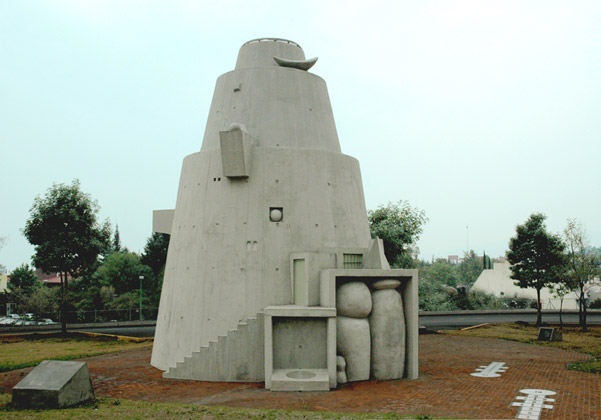Artist:
Pedro Reyes (born 1972 in Mexico City, Mexico; lives and works in Mexico City).
Description:
Reyes squatted inside La Torre de los Vientos, a 1968 sculpture by Gonzalo Fonseca, and used it as a studio and exhibition space for five years. Over 30 projects, events, and exhibitions took place while he was there.
“La Torre de los Vientos was created in 1968 by Gonzalo Fonseca as part of the sculptural complex Ruta de la Amistad designed for the Mexico ’68 Olympic games. This complex of 19 monumental sculptures placed alongside the Periferico highway was conceived and organized by Mathias Goeritz, and amongst them La Torre de los Vientos is the only one that has an interior space. In 1995 Pedro Reyes started to work in the sculpture, first using it as a studio space and later collaborating with other artists. In 1996 the space was restored by the Patronato Ruta de la Amistad and Pedro Reyes initiated a series of site-specific projects inside this sculpture. To this date Pedro Reyes organized more than 35 exhibitions in La Torre de los Vientos, working with artists such as Tsuyoshi Ozawa, Enrique Jezik, Mauricio Rocha, Robert Chambers, Silvia Gruner, Terence Gower, Santiago Sierra, Felice Varini, Gustavo Artigas, Germaine Koh, Thomas Glassford, Sean Snyder, Claudia Fernandez, Paulina Lasa, and Hector Zamora, amongst others.”
—Black Hole, “Popular Geometry: Mexico City,” e-flux, last modified May 19, 2004.
“Just after I finished architecture school I squatted La Torre de los Vientos, another modernist icon in the city. I felt irresistibly drawn to this concrete sculpture. When I got there it had been abandoned for 25 years. I broke the lock, bought a new one and started to use the space as my studio. Soon after, it became a laboratory for artist’s interventions. Not everyone knew it was hollow inside, and the space is absolutely stunning; it reminds me the Pantheon in Rome. The tower is shaped as a truncated cone, a round ziggurat. If you know it was built in 1968, you can recognize that postwar brutalism, but if you have to guess, you might mistake it for an ancient ruin. Some buildings are time machines. It’s the timelessness that Louis Kahn noticed in Barragan’s house. He said it could have been built 100 years in the past or 100 years in the future. At La Torre you are also catapulted into other ages: there are times when it feels like ancient Babylon, and others where it seems to be the scenery of some Martian chronicle. It sometimes gave me the impression of being in a Paleochristian catacomb that suddenly turned into a nuclear silo, or a space station.”
—Pedro Reyes, interview by Tatiana Cuevas, BOMB 94, Winter (2006).


